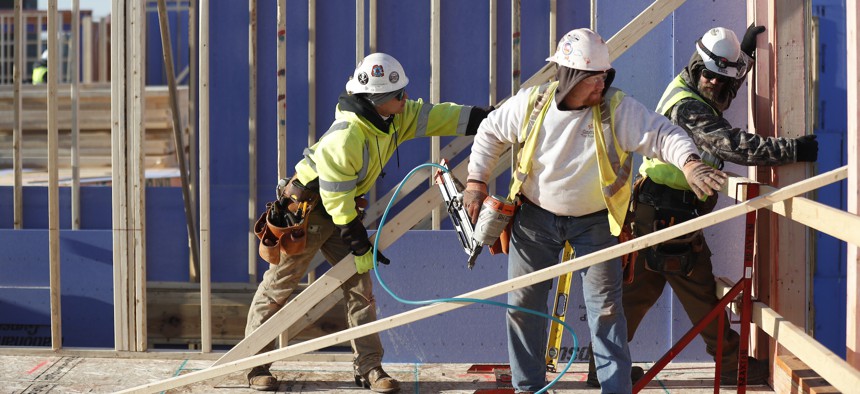Do land-use reforms spur housing development? You betcha.

Builders work on a 280-unit apartment building in Minneapolis in 2017. Jerry Holt/Star Tribune via Getty Images
After years of adjusting land-use regulations, Minneapolis boosted its housing stock by 12%, while rents grew at just 1%. Meanwhile, the rest of Minnesota increased its stock by 4% as rents rose 14%.
Minneapolis made headlines when it became the first major city to eliminate single-family zoning in 2019. But the City of Lakes had been chipping away at land-use restrictions for a decade, and a new study reveals how those efforts are paying off in big ways.
Between 2017 and 2022, Minneapolis increased its housing stock by 12%, while rents grew at just 1%, according to a new analysis from Pew Charitable Trusts. Compare that to the rest of Minnesota, where the housing stock increased by 4% while rents rose 14%, and it’s clear something is working in Minneapolis, says Alex Horowitz, director of Pew’s housing policy team. In fact, the city has the slowest rent-growth rate among the country’s major growing municipalities.
Minneapolis renters pay an estimated $1,700 less per year than they would if the rate matched the rest of the state. And while rents remain stable, wages in the city have increased, meaning “in income adjusted terms, rents in Minneapolis have dropped more than 20% in the last seven years,” Horowitz said.
The benefits of more housing ripple out to the community’s most vulnerable population. Homelessness in Hennepin County, where Minneapolis is located, decreased 12% between 2017 and 2022 while the rest of the state saw a 14% increase. Those figures are particularly salient in light of the U.S. Department of Housing and Urban Development’s recent report that found more people experiencing homelessness now than any time since 2007, when HUD began tracking the data, Horowitz noted.
“We're seeing that places that add the most housing and keep their rent growth low are seeing homelessness drop,” Horowitz said, “and the places that maintain restrictive zoning and make it hard to have enough homes for everyone—especially apartments—are seeing homelessness rise.”
To better understand the efficacy of Minneapolis’s policies behind the numbers, researchers wanted to know what kinds of developments were driving the growth.
Policies around parking and permitting near commercial areas and public transit were the two most important steps in encouraging housing construction, Horowitz said. Parking requirements significantly increase construction costs for housing developers, so the city began reducing such mandates in 2009 before eliminating them citywide in 2021. In 2020, the city created “zoning districts” to streamline approval processes and allow three-to-six-story buildings along commercial corridors and 10-to-30-story buildings near public transit.
Between 2017 and 2022, nearly 21,000 new units were permitted in the city. With reduced parking minimums and easy permitting in commercial corridors, about 87% of those units were part of large multifamily buildings with at least 20 apartments. Surprisingly, eliminating single-family zoning and allowing two-to-four-unit buildings on all residential lots in the city—the policy that garnered the most attention nationwide—accounted for only 1% of new permits.
Eliminating single-family zoning will slowly and steadily improve affordability and add housing stock, Horowitz said, and many communities are successfully using it as a tool to do just that. “It's just not as quick and doesn't have the short-term affordability impacts of allowing apartment buildings on commercial corridors,” he added.
But the housing crisis warrants an urgency that incremental approaches don’t meet, especially among renters. More than half of renters are at their limits, spending 30% or more of their income on housing, and there’s a 7.3 million deficit of affordable rental units available to low-income households. To address these challenges, governments at all levels need to rethink restrictive zoning.
“The Minneapolis example has clear lessons for other cities and for other states that are addressing serious problems with housing shortages, housing affordability and homelessness,” Horowitz said.






